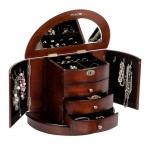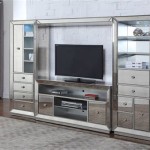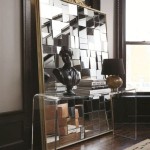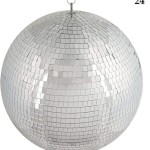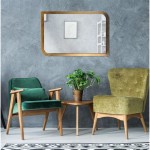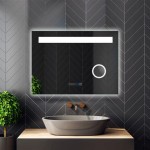Big Mirror Measurements: A Comprehensive Guide
Large mirrors significantly impact a room's aesthetics and functionality. Beyond merely reflecting images, they can amplify light, create the illusion of more space, and serve as striking decorative elements. However, choosing the right large mirror requires careful consideration of its dimensions and how they relate to the surrounding space.
1. Defining "Big": Understanding Scale and Proportion
The term "big" is relative to the space in which the mirror is placed. A mirror considered large in a small powder room might appear modest in a grand entryway. Therefore, understanding scale and proportion is crucial. Before selecting a large mirror, assess the dimensions of the wall it will occupy and the surrounding furniture. A general rule of thumb is that a large mirror should not occupy more than two-thirds the width of a piece of furniture placed beneath it, such as a console table or sideboard. This maintains balance and prevents the mirror from overwhelming the space.
2. Standard Large Mirror Sizes and Their Applications
While custom sizes are always an option, understanding standard large mirror sizes can simplify the selection process. Common large mirror dimensions include those exceeding 48 inches in height or width. Full-length mirrors, often around 72 inches tall and 30 inches wide, are ideal for bedrooms or dressing areas. Oversized round or rectangular mirrors, ranging from 40 to 60 inches in diameter or width, can make a dramatic statement above a fireplace or sofa. For larger walls, consider even grander proportions, but always keep the space's scale in mind.
3. Measuring for a Large Mirror: Key Considerations
Accurate measurements are essential when purchasing a large mirror. Begin by measuring the available wall space, both height and width. If the mirror is intended to hang above a piece of furniture, measure the furniture's width and leave a suitable amount of space between the top of the furniture and the bottom of the mirror, typically around 6 to 8 inches. This creates visual breathing room and prevents a cramped appearance. Also, consider the surrounding décor and architectural details, ensuring the mirror's size complements rather than clashes with existing elements.
4. Height Placement: Optimizing Reflection and Functionality
The height at which a large mirror is hung significantly impacts its functionality and visual effect. For full-length mirrors, the bottom edge should be close to the floor, allowing for a complete view of the reflection. When hanging a mirror above a piece of furniture, the center of the mirror should be at approximately eye level, typically around 60 to 66 inches from the floor, depending on the average height of those using the space. This ensures comfortable viewing and enhances the mirror's reflective properties.
5. Width and Shape Considerations: Balancing Aesthetics and Space
The width and shape of a large mirror contribute significantly to its overall impact. Round mirrors soften a room's angles and can be particularly effective in smaller spaces. Rectangular mirrors, especially those with a wider aspect ratio, can create a sense of expansiveness. When selecting the width, consider the surrounding elements and the desired effect. A large mirror in a narrow hallway, for example, might benefit from a slimmer profile to avoid overwhelming the space. In a larger room, a wider mirror can create a focal point and enhance the sense of grandeur.
6. Framing and Mounting: Impact on Perceived Size
The frame and mounting method can significantly influence the perceived size of a large mirror. A thick, ornate frame can add visual weight and make the mirror appear larger than its actual dimensions. Conversely, a thin, minimalist frame can create a sleeker, less imposing look. Similarly, the mounting method can affect the perceived size. A mirror flush-mounted to the wall will appear less prominent than one hung with decorative brackets or chains, which add visual depth and dimension.
7. Practical Considerations for Handling and Installation
Large mirrors require careful handling and installation due to their size and weight. Ensure adequate support during transport and installation. For exceptionally large or heavy mirrors, professional installation is highly recommended to prevent damage and ensure secure placement. Always use appropriate hanging hardware rated for the mirror's weight and consider the wall material when selecting anchors and screws. Proper installation is crucial for safety and longevity.

Loxley Rustic Oak Large Mirror Progressive Furnishings

Extra Large Wall Mounted Mirror Framed Rectangular By Kristalia Design Luciano Bertoncini

How To Measure Your Space For A Large Wall Mirror 2 Steps

Neutype 65 X 22 Gold Rectangular Full Length Floor Mirror With Stand And Aluminum Alloy Frame Com Wall

Bathroom Mirror Size Calculator

Bathroom Mirror Size Calculator

36 In W X 60 H Rectangle Big Wall Mirror For Bathroom Black Modern Mirrors With Aluminum Frame Hangs Em D0102h59r8x The Home Depot

In Stock Free Usa 100 Secure Checkout Easy Returns So Classy Here Is The Easiest Way To Add A Mirror French Antiques Large Floor
B 2262 Louis Xvi Big Mirror 19th Century 251 500 Furniture Eurotroc

Seafuloy 31 5 In W X 71 H Large Rectangle Black Alloy Framed Full Length Wall Mounted Standing Mirror Hz Z016 The Home Depot

